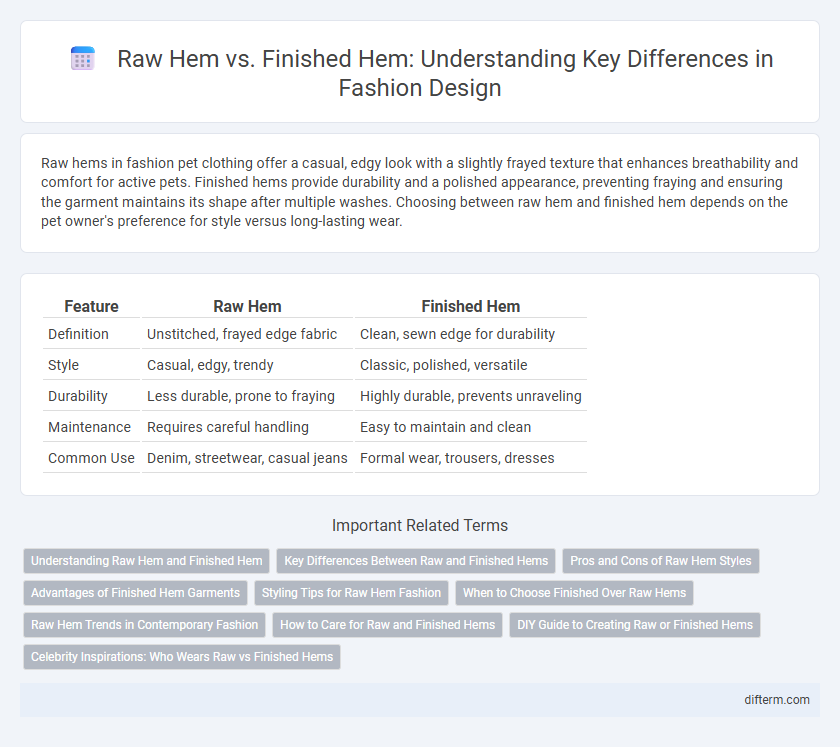Raw hems in fashion pet clothing offer a casual, edgy look with a slightly frayed texture that enhances breathability and comfort for active pets. Finished hems provide durability and a polished appearance, preventing fraying and ensuring the garment maintains its shape after multiple washes. Choosing between raw hem and finished hem depends on the pet owner's preference for style versus long-lasting wear.
Table of Comparison
| Feature | Raw Hem | Finished Hem |
|---|---|---|
| Definition | Unstitched, frayed edge fabric | Clean, sewn edge for durability |
| Style | Casual, edgy, trendy | Classic, polished, versatile |
| Durability | Less durable, prone to fraying | Highly durable, prevents unraveling |
| Maintenance | Requires careful handling | Easy to maintain and clean |
| Common Use | Denim, streetwear, casual jeans | Formal wear, trousers, dresses |
Understanding Raw Hem and Finished Hem
Raw hems feature fabric edges that are intentionally left unsewn, offering a casual, edgy aesthetic with visible fraying that evolves over time. Finished hems involve folded and stitched edges, providing durability, a polished look, and resistance to fraying, commonly found in formal or structured garments. Choosing between raw hem and finished hem influences the garment's style, maintenance, and longevity, making fabric type and desired appearance essential factors in hem selection.
Key Differences Between Raw and Finished Hems
Raw hems showcase an unfinished fabric edge, offering a casual, edgy aesthetic favored in denim and streetwear, while finished hems feature clean, sewn edges that prevent fraying and provide durability and polish. Finished hems utilize techniques such as folding, stitching, or binding to secure the fabric, enhancing garment longevity and visual refinement. Raw hems emphasize trend-driven, relaxed style, whereas finished hems prioritize structural integrity and a classic, tailored appearance.
Pros and Cons of Raw Hem Styles
Raw hem styles offer a trendy, edgy look with frayed edges that convey a casual, lived-in aesthetic appealing in streetwear and denim fashion. These hems require less production time and cost due to omitted stitching but tend to fray further with washing, potentially compromising garment durability. Raw hems lack the polished finish of finished hems, making them prone to unraveling and less suitable for formal or professional attire where clean lines are preferred.
Advantages of Finished Hem Garments
Finished hem garments offer superior durability and a polished look, preventing fabric fraying and extending the lifespan of the clothing. The clean edges provide a refined silhouette that enhances overall garment quality and style. High-end brands prioritize finished hems to ensure consistent craftsmanship and customer satisfaction.
Styling Tips for Raw Hem Fashion
Raw hem jeans offer a trendy, edgy look that pairs well with casual and street-style outfits, making them ideal for relaxed weekend wear or music festivals. Styling tips include balancing the rugged edge with polished pieces like tailored blazers or sleek ankle boots to achieve a chic contrast. Incorporate layered accessories and choose denim with slight distressing to enhance the authentic raw hem aesthetic.
When to Choose Finished Over Raw Hems
Finished hems provide a polished and durable edge ideal for professional or formal garments that require a clean, tailored appearance. Opt for finished hems on fabrics prone to fraying, such as woven cotton or silk, to enhance longevity and maintain shape after repeated washing. Choose them when the garment demands structure and a refined finish, ensuring longevity and preventing unraveling.
Raw Hem Trends in Contemporary Fashion
Raw hem trends in contemporary fashion emphasize an edgy, casual aesthetic by showcasing intentionally frayed or unfinished edges on garments like jeans, skirts, and shorts. This style highlights craftsmanship imperfections as a design feature, appealing to consumers seeking authentic, lived-in looks that contrast with polished, finished hems. Raw hems have become a staple in streetwear and high fashion collections, reflecting a growing preference for relaxed, nonconformist styles in modern wardrobes.
How to Care for Raw and Finished Hems
Raw hems require gentle washing and air drying to prevent fraying, with minimal agitation to maintain their edgy look, while avoiding bleach or harsh detergents. Finished hems offer greater durability and can usually withstand machine washing and tumble drying, but following garment-specific care labels is essential to preserve stitching integrity. Regular inspection of both hem types helps catch any wear early, extending the lifespan of the garment significantly.
DIY Guide to Creating Raw or Finished Hems
Creating raw hems involves cutting fabric without folding, providing a frayed, edgy look ideal for denim or casual wear; securing edges with fabric glue or a zigzag stitch prevents excessive unraveling. Finished hems require folding the fabric edge twice and sewing it down, offering a polished, durable appearance suited for dress shirts or skirts. Essential tools include sharp fabric scissors, matching thread, pins, and a sewing machine or needle for hand-stitching precise hems.
Celebrity Inspirations: Who Wears Raw vs Finished Hems
Celebrities like Zendaya and Gigi Hadid often rock raw hems, embracing the edgy, casual vibe that adds a touch of rebellious chic to their street style. In contrast, stars such as Blake Lively and Cate Blanchett prefer finished hems for their polished, sophisticated red carpet looks that exude timeless elegance. The choice between raw and finished hems in celebrity fashion highlights how hem finishes can define personal style and influence current fashion trends.
Raw Hem vs Finished Hem Infographic

 difterm.com
difterm.com